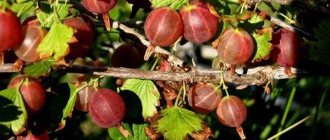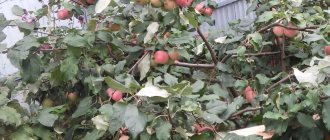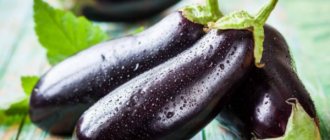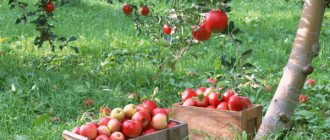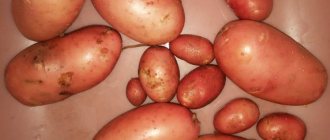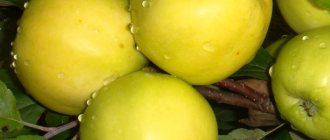Ordinary upright apple trees are now probably found in every garden. Even the columnar ones will surprise few people now. The creeping apple tree is not some kind of curiosity, but the same fruit crop, with a modified crown shape. The slate apple tree is highly resistant to low temperatures, which pleases the gardeners of Siberia, who created such a modified apple tree.
Creeping apple tree.
What is a creeping apple tree?
To describe it simply, a creeping apple tree is the same as others, its branches just don’t grow upward. There are varieties whose crown itself is squat. And there are representatives of the culture that have an elastic trunk and branches, so they can easily modify the shape of the crown.
To give the crown of an apple tree for Siberia a creeping shape, you need to start the formation by planting an annual seedling. The branches will need to be gradually bent to the ground, attaching a small load to them. Bend down carefully, without giving a large load, so as not to break the shoots.
The best apple varieties for Siberia
In cool conditions, it is best to grow non-standard, low-growing creeping trees. They are not as productive as ordinary apple trees, but their unusual shape allows them to be completely covered under snow cover and not freeze. The seedlings grow low above the soil in an inclined position, so the fruits have time to ripen faster, before the onset of frost. In addition, creeping apple trees look unusual, and the compact size of the crown simplifies harvesting. You can pick apples by hand without using special tools.
The best varieties of apple trees for Siberia and the Urals are considered: Bayana, Souvenir Altai, Borovinka, Zheblovskoye, Melba, Northern Sinap. These plants are most adapted to the conditions of regions with cold climates. The Melba apple tree is a Canadian variety characterized by large fruits that ripen in late August. Apples of this variety do not last long, only for a month. Descriptions, photos and reviews of the Borovinka apple tree indicate that this ancient variety is distinguished by excellent winter hardiness and attractive, tasty fruits that ripen in the fall. Their shelf life is twice as long as Melba’s - 2 months.
Advantages of the creeping form
The most important feature of a creeping apple tree is its low growth. This is the main purpose for which it was created. The height of half a meter ensures ease of use, primarily simplicity and the ability to completely cover the crop. In the cold Siberian climate, proper shelter for the winter will be the first and key step in growing crops.
This form also ensures early pregnancy. Fruits can be collected within 3 years after planting. Moreover, the lifespan of the culture is not reduced, as, for example, with dwarfs. With proper agricultural technology, an apple tree lives and bears fruit for 40-50 years.
Main difficulties and ways to overcome them
When growing a creeping apple tree, some difficulties may arise. For example, if the shelter is poor, the tree is frozen, or fruiting does not occur for a long time.
Saving a frozen apple tree
If in the spring the tree looks weakened, the leaves grow small and whitish, this means that it is frostbitten. Additional pruning is required to save it. After this, the apple tree needs to be fed. Soon new shoots will appear and the tree will restore development. The cut areas must be treated with garden varnish to prevent infection from occurring there.
Causes of creeping apple tree infertility
Fruiting of early varieties of apple trees begins 3-4 years after planting, late varieties - at 8 years. But it happens that after the specified period the tree does not grow fruit. There may be several reasons, the main ones are the following:
- the tree is planted incorrectly;
- the crown is not formed properly;
- when planting in the northern regions, varieties intended for the south were selected;
- proper care was not observed.
To avoid infertility, seedlings must be purchased from specialized farms. Having chosen the appropriate varieties and carried out the correct agricultural techniques, the gardener will definitely wait for the harvest from creeping apple trees.
Does the variety of apple matter?
Slate apple trees are an unspecified variety. This is a general definition of apple trees, which were shaped by gardeners in this way. It is important to choose a variety with high fruit characteristics so that your efforts are not in vain.
In practice, this can be done with any varieties that differ in maximum growth and ripening time. The main thing is that it has flexible wood. There are varieties that initially grow with a drooping, slate-like crown. These are considered Melba and Borovinka.
How to choose the right seedling
Apples in creeping forms can have different ripening periods, but you should carefully approach the choice of seedlings, selecting the most suitable apple trees for the Urals and Siberia. It is recommended to use local wild game as a rootstock, and make a scion from any variety you like. Plants with similar characteristics are most often sold in nurseries. Judging by the description, photo and reviews of the Borovinka apple tree, it is well suited for scioning and is widely used in these regions. When buying an apple tree, it is better to give preference to plants with a developed root system, fresh foliage and a thick stem.
How to grow a slate apple tree
The growing procedure takes place in stages. It begins with planting a young one-year-old seedling. It is planted vertically in the spring. After two weeks of growth, you need to cut off the top of the seedling and carefully tilt it.
After the first few branches have appeared, their growth also needs to be directed. They will grow vertically, but they need to be secured in a horizontal position, carefully using wire pins.
Slate-shaped apple tree.
The procedure must be performed correctly on young branches, those that have not yet become woody. If the stiffened one is tilted and then the support is removed from it, it will return to its original place. The branches must be positioned so that they are on different sides and do not interfere with each other.
Specifics of cultivation in Siberian conditions
The climate of Siberia is so harsh and aggressive that ordinary apple trees cannot survive in it. There are local varieties that are designed to grow in these conditions. But they have a number of disadvantages - small fruits, rather mediocre taste and, most often, a short shelf life.
That is why the creeping apple tree is an essential member of the fruit plot. Thanks to their crown lowered to the ground, they are easily covered with snow, which is a real protection from the cold. At the same time, the apple tree retains the shape and taste of the variety.
Description and characteristics of the variety and fruits
The Moscow apple tree later stands out for its tall growth. In the first years after planting, the young tree has a wide pyramidal crown shape, which, as the plant matures, takes on the shape of a wide oval. The central conductor and main skeletal branches are green-gray. Basically, the lateral processes grow in a vertically inclined position.
The dimensions of the sheet plates are characterized as average. Their shape is elliptical, the ends are pointed, and fibers form on the petioles. The smooth lateral processes have a rounded shape and strong pubescence. Their color is brownish-brown.
For this variety, the moment of removable maturity and consumer maturity coincides. This feature of the fruit allows them to be consumed immediately after picking, without waiting for complete ripening.
A slight blush is observed on the illuminated side of the fruit. According to the description of the variety, if the crop is stored for a long time, its color changes to golden.
Caring for a creeping apple tree
There are some subtleties of caring for an apple tree with a squat crown. It will need to be insulated with tops and spruce branches, and the trunk will need to be hilled. You need to throw as much snow as possible on top of the branches to retain heat.
How to save a frozen apple tree
Even the best shelter does not always save you from the cold. If the buds are weak and deformed, and the foliage is small and whitish, these are most often signs of freezing.
In this case, only pruning can help. Stimulating the growth of young shoots will help the entire plant recover. All branches damaged by frost must be removed completely, and living branches only partially, in order to speed up the appearance of young branches. Large areas of cuts must be immediately covered with garden varnish to prevent infection from entering the body.
After the pruning procedure, it is also necessary to feed and water the apple tree. The tree trunk circle needs to be mulched to retain moisture and protect against the germination of weeds, which can be a source of infection. Also, after pruning, it is recommended to spray with growth stimulants.
Whitewash
Whitewashing the trunk and skeletal branches will help protect the apple tree from sunburn. It will also help remove pest larvae and pupae. For whitewashing, lime, clay and mullein are used. Some people add a little glue to make the mixture stick well. It is recommended to carry out the procedure in the fall; before doing this, clean the tree trunk and the tree trunk from dirt.
Apple tree after whitewashing.
Rodent protection
It is important to protect the apple tree bark from rodents, especially for young plantings. Will help with this:
- use of creosote;
- wrapping with spruce branches;
- use of poisonous baits;
- wrapping with a special mesh.
Using these simple means, you can ensure a normal winter for your apple tree.
Weed control
It is very important to keep the tree trunk clean. Fungus or pests may appear in the grass, which can easily move onto the apple tree. Thickening will also negatively affect photosynthesis and fruit ripening.
To keep the tree trunk clean, you need to regularly loosen the soil and mulch it. Sawdust and cut grass without seeds are placed under the tree. A dense layer of mulching material will inhibit the development of weeds and retain moisture.
Watering
Slate trees are watered in the same way as ordinary ones. Moisture is applied according to a standard schedule, in spring and summer. The last application of moisture is carried out at the end of August or beginning of October.
Automatic watering of apple trees.
There is an important requirement regarding watering the plant. When moistening, it is necessary to lift the branches so as not to moisten them. They are placed on supports and left there until the water is absorbed.
Feeding the elks
Slate apple trees also need fertilizer, like any other crops. An important requirement is a normal level of acidity. To bring it back to normal, if it is too high, you need to add lime or dolomite flour to the soil. To, on the contrary, increase acidity, you need to add peat or sawdust.
The fertilizer application schedule is as follows:
- In the spring, fertilizers with nitrogen are applied. This can be humus, ammonium nitrate, nitroammophoska or urea;
- when the apple tree begins to bloom, you need to feed it with a solution of chicken droppings, superphosphate or urea;
- After the crop has flowered, you need to add nitrophoska or sodium humanate. Watering with a solution of mowed grass has a good effect;
- in the fall, elements of potassium and phosphorus are added to the root. This is a good preparation for winter, strengthening the apple tree’s immunity.
Often in the summer, instead of feeding the roots, mineral elements are applied along the leaf. They significantly increase resistance to cold.
Diseases and pests of stans
Preventive treatment of creeping apple trees differs from that for ordinary ones. The tree trunk circle must be regularly cleared of shoots and weeds in order to facilitate air access to the roots and not deprive the plants of nutrients. It is advisable to regularly mulch the soil around it to prevent the spread of weeds. The easiest way to process trees with a double-shouldered crown is when the branches of the stylite are directed in two directions. This makes working with a large adult apple tree much easier. Low-growing plants are damaged less frequently by pests than others, since insects prefer to lay larvae at heights.
One of the common diseases of apple trees is leaf and fruit scab. It manifests itself in the form of black spots on the fruits and a sooty coating on the foliage. The infection develops quickly in wet years, especially on heavily dense trees where the crown is not regularly pruned. The fruits of the affected tree begin to rot and the leaves begin to fall off. The disease should be treated with special chemicals. For prevention, Bordeaux mixture is used, regularly spraying plants with it. It is very important to regularly burn fallen leaves and fruits. Apple trees with strong immunity do not get scab, even if the spores of this fungus attach to the leaves.
Another common disease is moniliosis. It is expressed in rot of fruits, foliage and shoots. In young trees, a sharp blackening of skeletal shoots can be a manifestation of infection. Therefore, it is important to remove them in time, treating the cut and other cracks in the bark with garden varnish. For prevention, damaged and fallen fruits should be regularly destroyed.
Pruning a creeping apple tree
Carrying out the pruning procedure is an important step in caring for slate apple trees. It is held in the spring. It is important to control the growth and density of the crown and remove excess shoots in a timely manner.
Apple tree pruning diagram.
The first pruning is carried out on a young seedling, in the summer after planting. You need to cut 4-5 buds to stimulate the growth of lateral branches, which must be bent down immediately. They are hooked with special hooks, but so that they are located horizontally, but do not touch the ground.
It is necessary to remove all the spiny shoots; they grow very quickly and can turn a slate apple tree into a bush.
Side shoots are cut into two or three buds so that growth can come from them. Without pruning, the fruit becomes smaller, the apple tree gets sick and bears less fruit.
Decorative apple trees with red leaves
Many gardeners are increasingly using trees in landscape design whose foliage color is red with all shades, from purple to crimson. They most often have their bright appearance in the spring and turn green or bronze as the season progresses. Very often, due to the fact that branches of different ages are not trimmed, the appearance deteriorates greatly. Therefore, shaping is an important stage in growing ornamental varieties of apple trees.
Decorative apple tree with red leaves.
But they also have several disadvantages. They love sunny places, because it is there that the flowering is most lush and attractive. And it is also better to plant them on nutritious soil, because beautiful flowers consume a lot of useful substances. Accordingly, they need feeding.
How to form a creeping apple tree
Forming the crown of a creeping apple tree is a rather lengthy process and requires proper execution. It is very important to carry out the work every year and for 6 years. This period is enough for the crown to be fully and correctly formed.
Pruning of a creeping apple tree is carried out after planting; a young seedling is cut off so that lateral shoots appear. They are directed in different directions and pinched. To give the correct shape, metal hooks are used.
Errors that occur during formation
The first and most basic mistake is incorrect formation. Shoots need to be formed when they are flexible. If they have already become stiff, then you can tilt them, but by removing the hooks they will return to their original position.
Annual plan for the formation of shale
To make it easier to understand the pruning schedule, you need to take a closer look at the intricacies of the procedure depending on the season. Planting a seedling can be straight or at an angle, it is not so important.
in winter
In winter, all the procedures that remain for the gardener are covering the crown with plenty of snow.
in spring
At the beginning of spring, when it gets warmer, you need to remove the snow cover so that the apple tree does not suffocate. It will warm up a little and you can do spring pruning.
In summer
Summer is the right time for the formation of an apple tree. Just during the warm season, the shoots get used to the new shape.
in autumn
In addition to securing the branches with hooks, in the fall you also need to prepare the apple tree for winter. The trunk is whitened, hilled and mulched, the trunk is covered and insulated with spruce branches or a special mesh.
Growing stanza in Siberian conditions
Growing apple trees in the conditions of Siberia, where there are severe winter colds, is quite difficult.
Only slate is suitable for such climatic conditions. Its crown should be as close to the ground as possible. This will cover it with snow, which will protect it from the harsh Siberian frosts.
Insulation of the root system of the slate apple tree.
Caring for them has a number of differences. In autumn, the loose bark is removed from the trunk, whitened or wrapped in a light-colored cloth.
Particular attention should be paid to the roots. Fallen leaves, spoiled fruits and other debris under trees must be removed
To feed and insulate the roots, you need to cover the soil in the root zone with a layer of humus.
Important! The branches of the stanzas bend towards the soil and are secured with iron hooks. To protect trees from rodents, the branches that form the skeleton should be wrapped with dense synthetic fabric
When enough snow falls, the crown of the apple tree is covered. Having covered it with snow, additionally insulate it with burlap. Compact the edges with snow to prevent rodents from getting inside.
It is not recommended to cover the tree until snow has fallen. Mice can set up a home and destroy a tree.
Slates must be insulated and prepared for winter before severe frosts occur. This will prevent them from freezing.
In this region, creeping apple trees must be provided with proper care, taking into account all natural factors.
Reproduction
There are two main methods of propagation - grafting and instillation. You can graft the cuttings onto a special rootstock. It must be resistant to cold weather. The cuttings are cut in the fall, stored until spring, and then the cuttings are planted on the branch.
Apple tree cuttings.
Burying the branch is also very easy, because it is close to the ground. Usually, to root, you need to choose a young but elastic branch, cut it across a little and dig it into the ground. It is better to secure it a little with wire and water it little by little. Due to the incision, roots gradually appear. If you carry out the procedure in the spring, then in the fall you can cut off the mother branch.
Causes of creeping apple tree infertility
Typically, a one-year-old seedling grows and strengthens until it is 4 years old, then it enters the fruiting phase. If the variety is late, then you will have to wait 7-8 years.
There are several reasons why you may not see fruit:
- violations of landing technology;
- improperly formed crown;
- care impairment;
- freezing of the crop.
But if there are no such reasons, there may be one very banal one - the variety is simply not suitable for growing in Siberia.
Formation of apple trees from planting to fruiting
After landing
This is done primarily by pruning the seedling.
- If planted in the fall, prune after the severe frosts have passed, and this is not earlier than the end of February;
- If planted in spring, prune immediately;
- Correct existing deficiencies;
- Give the conductor a leading position;
- Having distributed the branches correctly (if any), pull them down and attach them lower to the ground;
- The next season, old growths are shortened, and new branches are freed from hooks;
- Leave two or three main branches for the first tier;
- Leave the branches at the same level;
- After 50-60 cm, leave one or two more branches;
- Bend non-main branches to a horizontal position.
Options for pruning young apple tree seedlings.
Remember! If the young shoot has grown less than 40 cm, do not shorten it.
In the first year
Let us consider the formation of the crown of an apple tree in the first year using the example of such a form of apple tree crown as sparse-tiered. This is what is widely used in our gardens.
First, decide what you have and what you want from the planted seedling (you are already familiar with the variety and nuances of forms).
- An annual seedling in spring, usually a stem without branches;
- It’s a pity, but shorten it from 40 to 80 cm from the ground;
- They try to purchase two-year-old seedlings (after all, they have already been growing for a whole year);
- If with branches, choose two or three lowest ones and growing in different directions;
- For the winter, tie the skeletal branches with twine;
- Do everything thoroughly and carefully;
- Having correctly formed the crown of young trees, you can only improve its characteristics and performance with maintenance pruning (formation of the crown of an apple tree in autumn and spring is equally possible at the appropriate time and timing);
- If you do it hastily, carelessly, you can destroy the young tree!
In the second year
How to form an apple tree for the second year:
- Remove grown branches from the trunk;
- Leave three branches above the trunk, preferably 15 cm apart, directed in different directions at an angle of at least 45 degrees, the strongest and healthiest, to form the first tier;
- Remove branches that have grown at the site where the trunk was trimmed and have an acute angle;
- Remove weak branches;
- Cut the conductor; it should be 15-20 cm higher than the tops of the remaining branches.
Note!
- Even in an adult tree, the central conductor should be located above the skeletal branches;
- Trim competitive and branching branches;
- Pull the remaining downward branches to a horizontal position - pull them towards the trunk.
Three year old apple tree
How to properly form a 3-year-old apple tree in the spring? Form a second tier - leave two branches placed approximately 50 cm above the first tier and directed in different directions.
- For skeletal ones, select branches with an angle of 40-60 degrees;
- Align all branches by pruning;
- Remove competing branches and intertwining ones;
- Shorten the conductor by a few centimeters;
- Remove bent branches that thicken the crown onto the ring;
- Begin the formation of the skeletal branches of the third tier.
Please note! The branches of young trees should not be severely shortened and prune them during these years as necessary. This affects the timing of the onset of fruiting.
Young apple tree
So, we have a young apple tree - pruning and shaping the crown of such an apple tree has several nuances:
- The goal is to ensure that you form a uniformly leafy and easy-to-maintain apple tree crown;
- Observe the subordination of both the conductor and each skeletal branch;
- You should carry out the main pruning before the buds open in early spring, and in the summer it is better to bend it back, pinching and breaking;
- Remove branches that are crossing, diseased, or extending into the crown.
Correct fit
There are certain planting rules for apple trees with a slate crown shape.
Selecting a landing site
There are several requirements for the place where the seedling will be placed. Among them:
- lack of proximity to groundwater;
- fertile soil;
- protected from gusts of wind.
The process of planting an apple tree.
A low-lying area is best so that the snow accumulates rather than being blown away by the wind in winter.
When is the best time to plant stanza?
It is believed that it can be planted in spring or autumn. In spring, this occurs before the buds begin to bloom. In autumn, planting is carried out 20 days before frost.
But in practice, gardeners recommend planting a tree in the spring. Then you can immediately begin to form the crown. It is also worth considering that the climate of Siberia can be unpredictable, so theoretically it is possible to calculate a suitable period before the onset of frost, but in practice the weather can change dramatically.
How to plant correctly
The seedlings are planted as usual - in a hole with fertile soil and fertilizers. The landing pit is prepared in the same way as in any other case.
It is better to install the shale culture at an angle of up to 45 degrees. Moreover, the top should be directed to the south. With this method of planting, the root neck deepens by 5 cm.
After planting, it is necessary to water the crop well and mulch. Caring for a creeping apple tree after planting is the same as for a regular one.
Rootstocks for creeping apple trees
Those who plan to grow stlanza on rootstocks are wondering which variety to choose. It is noteworthy that there are no special requirements, only resistance to the conditions of Siberia and was not fragile.
Some gardeners note the advantages of the Progress clonal rootstock. This young, but very promising variety is characterized by amazing resistance to cold, both in the root system and in the shoots.
How to plant an unusual apple tree
For planting, choose any variety of apple trees, but preferably those with large and tasty fruits. In addition, in cold areas it is better to select those bred for the northern regions, otherwise even in the form of stanza they may not survive after a harsh winter. You need to purchase seedlings from garden nurseries.
Site selection and site preparation
The landing site should be well lit by the sun and protected from cold winds. The crop does not tolerate high humidity, so groundwater should not come close to the soil surface. 2 weeks before planting, the area is cleared of weeds and debris. Then a hole is dug and filled ⅔ with a mixture of fertile soil, humus, and turf soil.
Slate planting dates
The most favorable time for planting seedlings is early spring. A seedling is selected on which the buds have not yet bloomed. In addition, trees can be planted in the fall, in September-October. As soon as frost sets in, the trunks are tilted and attached to the ground with hooks. Horizontal shoots can be easily covered with special material.
See also
Description and planting of the Dream apple tree variety, care and propagation
Read
How to plant correctly
An annual seedling is chosen for planting: it will adapt most quickly to new conditions. Planted at an angle of 40° or traditionally vertically. Planting an apple tree is done as follows:
- place the seedling in the middle of the prepared hole;
- straighten the roots;
- cover with earth, lightly compact;
- water abundantly.
After planting, the soil around the seedling is sprinkled with humus, straw, and peat. Mulch will protect the soil from drying out and the roots from overheating in summer and freezing in winter.
For Eastern Siberia
Eastern Siberia is a harsh region with an unpredictable climate. One thing is clear - it is very cold here in winter. Winter temperatures can drop to incredible levels. A temperature of minus 82 degrees was even recorded. The climate here is sharply continental, dry and harsh. In order not to die in winter and bear fruit in summer, the apple tree must have extremely high frost resistance.
Lydia
A relatively new, small-fruited, partially self-fertile variety, bred specifically for Eastern Siberia. On variety testing since 2005. The trees are low-growing - 4.4 m, the crowns are round. Harvest - end of August. About 10-11 kg of apples or 7-7.5 t/ha are harvested from a tree. Fruits in the 4th year.
Apples weigh 10-15 g. Apples are bright red and attractive. It is not affected by scab in the area of zoning. Winter hardiness and drought resistance are high. Fruits periodically, but without sudden changes.
Autumn joy
Belongs to early autumn varieties. For harsh climates. Harvest - end of August or later. They collect up to 150 kg from a tree. Fruits in the 4th year after planting.
The fruits are medium-sized, up to 150 g. Increased resistance to scab. The flat-round, slightly cone-shaped fruits are golden-green in color. Lots of strokes and blurry stripes. Storage – 1.5 months. The taste is dessert.
Young naturalist
Ripens in early autumn. Old variety - bred in 1935. Tree height - up to 4 m. The crown is round, drooping under the weight of the fruit. The variety is recommended for industrial cultivation. The average yield is 175 kg, maximum 200 kg per tree.
High resistance to scab. Even in the harshest winters it freezes slightly. The round-flat fruits are medium-sized, up to 130 g. The main background is yellow-green, apples with an elegant cover color - with bright red stripes. The creamy pulp has a dessert, sweet and sour taste. They keep fresh until almost January. They are well transported and suitable for any processing.
Kindergarten
One of the most popular varieties among Siberian gardeners. Self-sterile. Early autumn ripening. The trees are vigorous, with rounded crowns. It bears fruit only in 6-7 years. An average of 40 kg is collected from a tree; there are harvests of 80-90 kg. Ripening - 2nd half of September.
Dark red apples are medium, up to 60 g. There are large white subcutaneous dots. The shape is flattened. The taste is wine-sweet. Very beautiful dessert apples. Eaten fresh and processed. Frost-resistant variety, shelf life - 2 months.
Minusinsk dessert (Nadezhda)
Summer variety with periodic fruiting. Bred in 1954. Trees are of medium height - up to 3.3 m. Grows quickly. The fruits ripen in mid-August. Shedding – up to 20%. The variety is early-bearing - produces fruits in the 3rd year. Up to 17 kg are collected from a tree, 11 tons from 1 hectare.
The apples are the same size, rather small, weigh 20-28 g. The main background is golden, with orange on top. There are gray dots on the peel. The creamy pulp has a sweet and sour taste and rich aroma. The fruits are universal. High frost and drought resistance. The downside is that with large harvests the apples become smaller.
Aftercare
Pruning an apple tree is stressful. After the procedure, the tree needs additional care.
In the spring and summer, after pruning, fertilizers with a high content of nitrogen, phosphorus and potassium should be applied. Ammofoska, saltpeter, urea, diluted chicken manure and mullein have proven themselves well.
If pruning was carried out at the end of summer or autumn, then preference is given to compositions with a high content of potassium and phosphorus.
Important! Nitrogen fertilizing at the end of summer promotes the active growth of young shoots. The thin bark is not able to withstand severe frosts, which leads to frostbite of the branches and death of the tree.
After feeding, the trees are watered abundantly with water - 2-3 buckets for each square meter.
Meet the most popular dwarfs
The most popular types of dwarf apple trees are: Wonderful, Bradchud and Grounded. You won’t be able to vaccinate them on your own, so you should seek help from specialists. For example, to a nursery.
- Wonderful. The variety is late summer and has a high yield. It is convenient because it can be grown in any soil, and therefore throughout all territories of Russia. Its main characteristic features are height (no more than 3 m), standard (small), medium-sized fruits (their weight reaches 150 grams, they have a blush on the green-yellow peel).
The grains of apples of this variety are small, and the pulp is very juicy. The taste is not for everyone - sweet and sour. Harvesting occurs at the beginning of September, but up to 70 kg can be harvested from just one dwarf.
The fruits are perfectly stored. If stored properly, they will last more than 60 days. The tree itself is unusually resistant to frost. It is rightly called a miracle pollinator of all varieties and types of dwarf apple trees. To make its pollination more successful, it is better to plant Sverdlovsk Anise nearby.
- Bradchud. Its height reaches 2 meters. The crown can have a diameter of up to 3 meters. The leaves are very large and therefore it is impossible to confuse Bradchud with another variety. One apple can weigh 150 g. But there is also a smallest weight - 100, and a maximum - 250. The variety is also noticeable in the fruit: a seam will be visible on one of the sides. The skin is dry and does not have a dusting or waxy coating. The color is greenish-yellow, but it has a peculiarity - a large purple spot on half of the fruit.
The grains of the apples are large, and the pulp is very juicy and white. Taste qualities – sweet and sour. Full ripening occurs only at the end of September - beginning of October. Since the species is considered winter, the fruits can be stored until spring. At the same time, they do not spoil at all, but retain a delicate pleasant taste and aroma.
- Down to earth. Unlike previous varieties, it has small fruits. Weight reaches a maximum of 110 grams. The shape is slightly flattened and the skin of the apple is buttery. The fruits are very juicy and have a sweet and sour taste. They are not stored for very long (up to 50 days), but are well suited for preserves, juices and jams. The main advantage of the variety is that it is compact and takes up little space. This is very convenient for planting small areas. It also tolerates frost well. The growing season is a maximum of 150 days.
Each variety is unique and beautiful. Among the mass of varieties and types of dwarf apple trees, you can choose the one you like.
